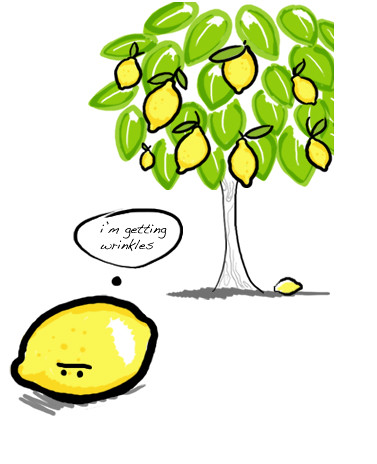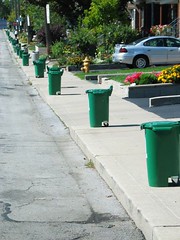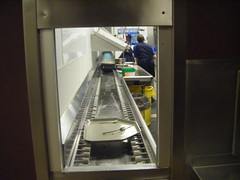This Tuesday, I wrote about online food swapping sites. Another such site, Veggie Trader, has only been operating for a few weeks, but is already creating some buzz. Rob Anderson, one of the site’s Portland-based creators, was nice enough to answer a few questions:
How’d you come up with the idea for Veggie Trader?
A few years back we started noticing all the excess stuff growing in our neighborhood and going to waste. It was everywhere. While we think splattered plums on the sidewalk make for interesting abstract art, we do believe fruit has a higher calling. We think much of the problem is folks don’t know what to do with their super productive orange tree. Or they plant too many beans, basil, or kale. We figured Veggie Trader would give people a forum to help put their backyards to maximum use.
What’s your vision for the site?
Next time you’re out for a walk, take a look around. There’s a wealth of food growing right in our own backyards. People love to garden. We plant fruit trees, grape vines and fuss over our summer tomatoes. But too often much of what we grow ends up wasted. At the height of the harvest season, there are only so many tomatoes or squash one family can consume.
The idea behind Veggie Trader is to bring people together to share in the bounty and put it all to good use. Gardeners can use the website to trade for variety, find charities to donate to, or even sell their excess to make a few extra dollars. Those simply looking for local food can quickly get in touch with neighbors who have it.
 Who does the cool art and do lemons really lament their wrinkles?
Who does the cool art and do lemons really lament their wrinkles?
Yes, they do! Lemons just want to be useful. They want to be enjoyed and squeezed in the prime of life… The art is entirely the handiwork of Tam, one of the creators of the site.
What was the first trade/sale?
It’s early yet and we don’t monitor trades, but we intend to make a place available on the site soon where people can share their experiences with us. It will be interesting to see what people say, and we can’t wait to hear their stories.
What has been the most popular item?
This time of year, seeds and starts seems to be the most popular listings.
Any funny anecdotes, thus far?
More like a quote: “I wish I had this last year so I didn’t have a yard full of raccoons getting drunk off my fermenting plums.â€
In your mind, is there a critical mass for how many users you need?
We’re only a couple weeks old and just want to get the word out so people know they now have a place to share their extra veggies or find local food. We think it’s a great idea and hope and expect it to grow and succeed. Over 600 people have registered for the site in just the past week, and there are over a couple dozen posts so far. A lot of people are telling us they can’t wait to come back and list their produce once the growing season really kicks in. Right now, we’re encouraging people to post what they have and what they’re looking for.
How far do you think people will travel to swap or buy produce?
No idea, but we designed Veggie Trader in the hopes of bringing people together in their local communities. However, one person did ask how she might search the entire country for produce instead of simply by zip code. We told her how she could do this, but noted traveling across the country is a long way to go for homegrown fruits and veggies!
Is the action thus far just in warm weather states?
We’ve seen people registering and posting listings all across the country. It’s hard to determine a pattern just yet though. I can say a lot of people from Southern California and Arizona have visited the site. Then again, we seem to be getting a lot of people registering in Ohio as well.
Did you consider starting in one location and expanding to different cities slowly?
At first we thought about starting up just in our home base of Portland, Oregon. But then we realized Veggie Trader can be just as useful in Austin, Denver, Los Angeles, or anywhere in the country. There’s been a tremendous amount of interest from all over.
We have lots of changes we plan to make to Veggie Trader to make it better and easier to use. If people have suggestions, we encourage them to contact us via the site and let us know how we can make it a better
resource.
 cleaning can’t hurt. Taking stock of the foods you bought but didn’t use can be instructive for avoiding future waste. Barrow uses the occasion as a chance to reflect on her food-buying habits.
cleaning can’t hurt. Taking stock of the foods you bought but didn’t use can be instructive for avoiding future waste. Barrow uses the occasion as a chance to reflect on her food-buying habits. My ears perked up as Wansink described how he and his crew in the
My ears perked up as Wansink described how he and his crew in the  The purveyor of waste-inducing portions recently started
The purveyor of waste-inducing portions recently started  First, students are more likely to overindulge when they’re serving themselves. It’s the classic eyes vs. stomach conundrum.
First, students are more likely to overindulge when they’re serving themselves. It’s the classic eyes vs. stomach conundrum.
 Who does
Who does  The entry is now a semi-finalist, but could use all the help it can get. It’s up against some amazing ideas like
The entry is now a semi-finalist, but could use all the help it can get. It’s up against some amazing ideas like  As far as I know, it’s the first such case of mandatory food waste collection. Let’s call it compelled composting. And it makes sense that it’s happening in Seattle, which began curbside recycling in 1988.
As far as I know, it’s the first such case of mandatory food waste collection. Let’s call it compelled composting. And it makes sense that it’s happening in Seattle, which began curbside recycling in 1988.